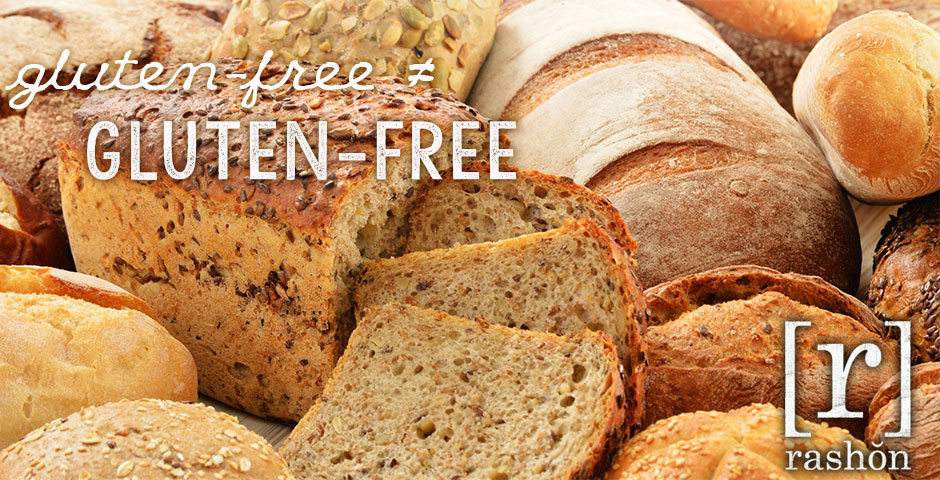I don’t, in fact, eat foods containing gluten; however, I hate being labeled gluten-free. (I don’t enjoy labels.) When you tell someone that you are gluten-free, they assume that you will eat any gluten-free replacement, and for me, that’s just not the case. I do occasionally have a gluten-free replacement, but it’s a treat. Do you know how much junk is in those gluten-free breads, crackers, pizza crusts, etc.? A lot. The carb load is unreal, and ultimately, it’s just processed food. That carb load leads to major blood sugar spikes.
I highly recommend reading Wheat Belly by Dr. William Davis for a more in-depth look at why wheat should leave your diet. Dwarf, hybridized wheat is the culprit behind a vast majority of our physical and mental health issues – gluten is only one small part of that. Here are a few of the facts that are discussed in the book:
- Gliadin, a component of gluten proteins is broken down in the intestines into small proteins that have the ability cross into the brain and bind to morphine receptors. This may be part of the reason wheat-filled products increase appetite and cause addiction-like behavior in some people. Have you ever started eating pasta or cake or any other wheat treat and felt like you couldn’t stop eating it? You just want one more bite? That’s because wheat has an opiate-like effect on our brains – we are (or can be) addicted to it!
- amylopectin A is a complex carbohydrate unique to wheat that is super digestible. Rice, beans and other starchy foods have amylopectin B and C and are less digestible. Considering that amylopectin A is so highly digestible, explains why eating two slices of whole wheat bread raises our blood sugar higher than table sugar, a bowl of brown rice or even a Snickers bar. That whole wheat toast you’re eating in the morning is packing a major punch of increased blood sugar! Repeated high blood sugar can lead to belly fat, general weight gain and diabetes, along with cataracts, arthritis and heart disease.
- Lectins (glycoproteins) in wheat bypass the protective proteins in our small intestines and enter directly into our blood stream. When these foreign bodies enter the blood stream, it triggers autoimmune responses and chronic inflammation in the body. Chronic inflammation can lead to arthritis, cancer, heart disease, digestive issues, food allergies, anxiety, depression, ADD/ADHD, Alzhiemer’s, migraines, endometriosis, obesity, diabetes, asthma, seasonal allergies, acne, eczema, and psoriasis. This is by no means a comprehensive list, but it should give you a good idea of how devastating inflammation is for your body. Understanding what might be causing inflammation is really important so that it can be prevented. If you have an autoimmune disease, there’s a good chance that removing wheat from your diet will help alleviate or eliminate symptoms.
- Beyond gluten, there are more than 1000 other proteins in wheat that have the potential to cause odd, or even dangerous, reactions in our bodies.
That information alone was enough to make me ditch the wheat, and my body has thanked me for it.
Now to get back to those junky gluten-free items. Yes, so they are free of the nightmarish effects of wheat listed above, BUT they are packed with starchy, blood-sugar-raising flours and ingredients. We read a little above about what happens when you have raised blood sugar, and I for one, would like to avoid diabetes and weight gain – not to mention all the other conditions associated with inflammation. That’s why occasional gluten-free crackers or other replacements are just that – occasional treats for me. So when I tell you I’m gluten-free, I probably don’t want a gluten-free bun for my burger. I’ll have it lettuce wrapped instead. I know that out in the real world, we often have to use the term gluten-free at restaurants or in people’s homes so that they easily understand our eating restrictions; however, for me, gluten-free ≠ gluten-free.
Being gluten-free should not mean replacing all the old wheat-filled standbys with gluten-free replacements. We need to be focusing on real, whole foods that don’t cause major carb-induced blood sugar spikes, and that also provide our bodies with energy and healing nutrients. There will be more to come on food substitutions and eating wheat-free, but for now, let’s get rid of the gluten-free label.




0 Comment